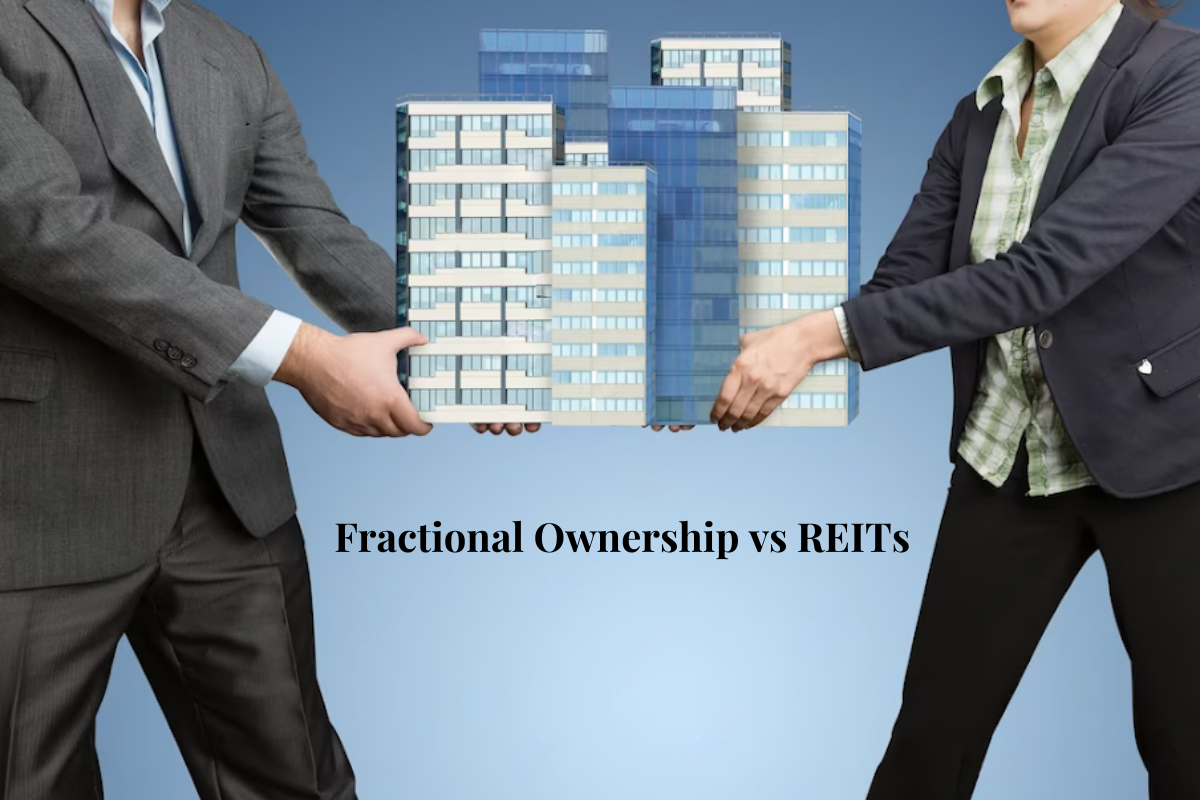What Would You Choose? Fractional Investment or Traditional Investment?
Real estate investing is considered to be a secure investment mode. Despite that, there is another general opinion about real estate investment that it is too expensive for retail investors. However, the appearance of fractional investment in the field altered this fact. This is where comes the question of fractional investment vs traditional investment.
Traditional investment has been dominating the real estate market for many decades. On the other hand, fractional investment is a comparatively new concept ruling the current real estate market. As a result, people are confused about which one to choose between fractional and traditional real estate investing. So, we are going to have a detailed discussion about the different aspects associated with it.
Concept of Fractional Investment and Traditional Investment
Fractional investment and traditional investment are two different modes of investment in general. The central point related to fractional investment vs. traditional investment is that fractional investment indicates investing in a fraction of a property, whereas traditional investment means investing in the whole property.
The traditional mode of real estate investment lets you invest in physical assets in different property types. These include residential properties, commercial properties, industrial properties, and land.
Yet, fractional investment lets you invest in partial shares of real estate assets. You can invest in fractional shares at a comparatively lower cost. This way, you become a fractional owner of the invested property. However, you own the property collectively with other co-investors investing in it.
The Growing Popularity of Fractional Investment in Recent Years
Fractional real estate investment has been gaining considerable popularity in recent years. The primary reason behind this is the lowered investment amount set by this investment mode, which was unattainable previously. Apart from the affordability, several other fractional investment benefits also need consideration here.
The low minimum investment costs make fractional ownership accessible for all willing investors. Moreover, fractional investment is a collective approach. So, this investment mode lowers the difficulties of property management.
Fractional ownership lets a group of investors invest collectively in one single asset. Thus, their ownership of the property along with all the shares and responsibilities also becomes collective. So, all the investors will convey the prospective risks, profits, and losses collectively. This will save them from substantial personal losses if the investment doesn’t go in their favor. So, this collective approach is one of the topmost fractional investment benefits.
Again, fractional real estate investing has considerable scope for diversification. This is another reason behind the recent popularity of this investment mode.
Fractional Investment
Fractional investment is a recent favorite of real estate investors. It is an easier and more convenient way of real estate investing compared to traditional investment. So, investors as well as people willing to invest in real estate are curious about it. Let’s have a detailed discussion about all the aspects of fractional investment in real estate.
Definition and Characteristics
As mentioned, fractional investment is a mode of investment, where you invest in a fraction(s) of an investment asset instead of investing in the whole asset as it happens in the traditional form of investment.
So, in real estate investing, fractional investment means investing in a partial share of a high-yielding real estate asset.
Fractional investing platforms offer different types of fractional ownership options. Among them, timeshare and joint development agreements (JDA) can be mentioned. Such crowdfunding platforms let investors invest in fractional real estate shares through Special Purpose Vehicles (SPVs).
The SPVs pool funds from multiple investors according to a pre-decided ratio and purchase a premium quality commercial real estate asset. Based on their investment ratios, the investors become partial owners of their fractional shares. In India, an amount between 15 to 25 lakhs is an ideal minimum investment amount for fractional ownership.
Let’s summarise the most significant features of fractional investment:
- Fractional investment is fractional. That means, in this investment type, you invest in a fractional share of a property and become a fractional owner of that partial share.
- Fractional investment lets you invest in Grade-A commercial properties.
- Fractional ownership platforms offer fractional investment opportunities to investors through Special Purpose Vehicles.
- Compared to traditional real estate investment, fractional ownership in real estate requires a much lower investment capital.
- You don’t have to be an institutional investor to invest through fractional investing.
Benefits of Fractional Investment:
The fast-growing popularity of fractional investment indicates noticeable fractional investment benefits. Let’s explore them in detail.
- If you are an individual investor with a limited budget, fractional investment brings a great opportunity for you. It lets you invest in institutional-class commercial properties, which would be otherwise impossible for you.
- A considerably low minimum investment amount is another advantage of fractional ownership. This makes the dream of real estate investing a reality for all willing investors.
- Investors investing in any investment asset want their investment portfolios to include diversification. In fractional real estate investment, you can diversify your portfolio easily by adding multiple fractional shares from different investment assets.
- Another one of the most significant fractional investment benefits is good capital appreciation. Providing 8-12% ROI through commercial real estate assets, it is a great source of passive income.
- Here, you have other co-investors with you to manage and take care of the entire investment asset collectively. Collecting rentals and managing tenants also become easier with fractional ownership.
Drawbacks of Fractional Investment
Like any other investment type, Fractional ownership also involves certain drawbacks. Here is a discussion on the matter.
- The issues faced in liquidity are a remarkable concern involved in fractional ownership. Buying, and especially selling, a fractional share is not as easy as buying or selling a stock.
- A particular fractional investment involves multiple owners of a single real estate asset. So, there are high chances of conflicts or disputes among the co-owners about the management or maintenance of the property.
- Another one of the most significant drawbacks of fractional investment is related to tax benefits. The tax benefits normally available to individual real estate investors or direct property owners are not available to fractional owners.
- Fractional real estate ownership platforms usually charge various fees including annual management fees, transaction fees, etc.
- Here you don’t have complete control over your investment. This is another disadvantage of fractional real estate investing. Since you share the invested asset with multiple co-investors, you can have only partial ownership and partial control over it.
Traditional Investment
Traditional real estate investment is the most widely accepted form of real estate investment. This is the oldest form of real estate investment, which has been prevailing for a long time, and still dominating the market.
Traditional investment benefits and disadvantages like monetary benefits and monetary losses are much greater compared to fractional investment. The reason is that traditional investment involves a substantial amount.
Here, to explore all the features, benefits, and drawbacks of traditional investment, let’s have a detailed discussion on the topic.
Definition and Characteristics
Traditional real estate investment indicates direct property ownership. Here, an investor purchases a commercial, residential, or industrial property to generate rental income out of it or make a good return on investment by selling it.
So, here, when you buy a physical property, you become the sole owner of the property. Thus, all the upcoming profits, losses, responsibilities, and challenges are on your shoulders.
Unlike fractional ownership, this mode of real estate investing involves full ownership of a property. Since you share the complete ownership of the property, you are the only one to take responsibility for all the expenses related to the property. With that, here also comes the individual property management and maintenance responsibilities.
Investing in an entire physical property and becoming a complete owner of it involves a large capital investment. So, traditional real estate investment is not as accessible to everyone as fractional investment.
Certain significant characteristics shared by traditional real estate investment are as follows:
- The traditional mode of real estate investing involves direct or active ownership of an asset. It needs more hands-on approaches compared to fractional investment.
- Traditional real estate investment usually indicates long-term property investment.
- This investment mode has a large capital requirement.
- Since it involves a substantial investment amount, traditional real estate investment is best suited for experienced investors.
- Traditional real estate investment is an individual approach, not a collaborative or shared approach. Here, all the profits, losses, challenges, and responsibilities related to an investment asset impact the single owner of the property.
Types of Traditional Investments:
Real estate investing includes multiple investment types except for fractional investment. However, traditional real estate investment indicates direct property ownership only. Here, an investor buys or invests in a residential, commercial, or industrial property to generate a good income out of it.
Direct and active property investment through whole ownership involves two main investing types:
- Generating high-yielding rental income after purchasing a property is a popular way of traditional real estate investment.
- Many real estate investors buy an average property at a reasonable price to renovate it and resell it at a higher price. This type of traditional investment involves substantial one-time profit.
Benefits of Traditional Investment:
- One of the most important Traditional investment benefits is that an investor gets full ownership of the invested property in this real estate investment type. This means, the investor also gets full control of the property.
- Another advantage here is the regulatory support available to individual investors.
- Traditional real estate assets usually share a long-term track record of their performance and income generation history.
- Traditional real estate properties are highly available and accessible through brokerage platforms and other real estate or financial platforms.
Drawbacks of Traditional Investment:
- One major drawback of traditional real estate investing is the high capital requirement.
- This mode of real estate investment allows limited diversification options for your investment portfolio.
- A risk for potential loss is always inherent in traditional real estate investment.
Time commitment and active involvement are important in traditional real estate investing. This can also be a potential challenge for the investor.
Factors to Consider When Choosing Between Fractional Investment and Traditional Investment
Choosing between fractional investment and traditional investment requires considering multiple factors. Here, we’ll discuss the key factors while considering fractional investment vs traditional investment.
- Traditional real estate investment requires a substantial minimum investment amount. But, the price requirement is reasonable with fractional real estate ownership. So, if you have a large amount to invest in a traditional property, you are good to go. Otherwise, fractional ownership is the right option for you.
- If you are a busy professional with no time to actively manage your investment, fractional ownership will suit you best. And, if you can commit a good amount of time to your investment, then you can go with the other option.
- Fractional real estate investing is the best option for those preferring passive investment. If you want to actively manage and fully control your investment, then the traditional way will suit you best.
- If you are risk-conscious, a better diversification opportunity will be a better choice. In such cases, consider investing in fractional real estate than in traditional real estate assets.
However, the most primary thing in considering fractional investment vs traditional investment is that, if you have money and time, you can go for traditional real estate investment. Otherwise, fractional real estate ownership is the right option for you.
Conclusion
While comparing fractional investment and traditional investment, it is clear that these two are two different modes of real estate investment. The arrival of fractional investment in the real estate market has indeed brought a challenge for traditional real estate investment.
But, these two modes of real estate investing are not replaceable by each other, as their characteristics are also different. Since they address different types of real estate investors, choosing the perfect one depends upon the requirements of the investors.
Related Blogs from real-estate-investment
-1728312198.webp)
A complete guideline to know the purchase of property by NRI in India
-1727684160.webp)
All the key information about interest on loan for house property
 (1) (1)-1721317471.webp)
A comprehensive guide regarding types of real estate property that will make you intelligible
-1721135437.webp)
Top Strategies for Successful Property Investment: Maximizing Returns in Real Estate
-1714373785.webp)
Know Guwahati Property Tax Better To Have Saving And Investment Opportunities!

The Role of Technology in Fractional Investment in Real Estate
-1707824784.webp)
Legal Considerations for Fractional Real Estate Investors

Explore The Types Of Models In Fractional Investing

Diversifying Your Investment Portfolio with Fractional Real Estate

Fractional Ownership vs REITs- Which one is better?
-1706600552.webp)
What Would You Choose? Fractional Investment or Traditional Investment?

Best benefits of fractional Ownership- Learn more about Fractional property investment

How to Choose the Right Platform for Fractional Real Estate Investment?

Check out! How fractional ownership works for You. Now!

A New Era of Investment- Build Your Real Estate Portfolio With Fractional Investment

How is Fractional Ownership in Commercial Real Estate changing?
Latest Blogs from Buying

7 Mistakes to Avoid While Purchasing Land
Land purchasing is considered to be a crucial decision taken in a lifetime. So, avoiding the prospective mistakes during the process is also very important. Revealing those mistakes, this blog leads you toward the right approaches to buying land.

6 Common Factors to Mind Before You Buy Land
Buying a plot of land involves thoughtful considerations and good planning. This blog discussing six crucial factors that need to be considered before purchasing land will guide you throughout your land-purchasing journey.

Point of View of a Buyer: Journey of Purchasing Land
Being a land buyer, it is important to know the entire process of land purchasing including all the requirements and upcoming challenges. This blog discusses this process in a detailed way, making your land-purchasing experience smooth.

Add Comment